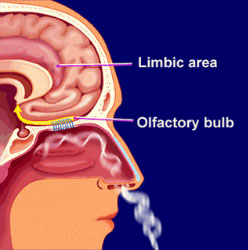(source 31)
Smell
Who Knows About the Nose?
Olfaction, or smelling, is the process by which chemicals signals are translated into neural impulses via the nose. Chemicals in the air enter the nose through the nostril. They then dissolve in mucus located within a structure called the olfactory epithelium. The chemicals then trigger specific cilia located within the olfactory epithelium, though know one knows why certain cilia are affected by specific chemicals. The cilia generate electrical responses which are then passed to the olfactory bulb. The olfactory bulb transmits signals to the brain via the olfactory tract (30).
Shedding Light on the Bulb
Definition:
Olfactory bulb- The part of the olfactory system that connects the naval cavity with the olfactory tract and the brain. It contains the olfactory nerve which transmits sensory signals to the brain to be processed (27).

(source 29)
A Sniff Down Memory Lane
Have you ever smelled something that reminded you of your grandmother’s house, or felt nostalgic when you inhale the scent of an old book? This is because of smell’s close relationship with memory. Why is this? The olfactory bulb, which processes smells, is a part of the limbic system which plays a large role in emotions and memory. These brain structures (specifically the amygdala, hippocampus, and olfactory bulb) often work together to create the emotionally-rooted memories that are often attributed to smell (28).
